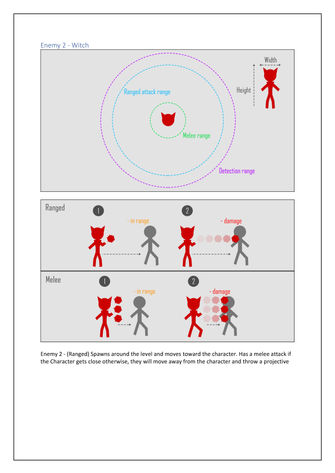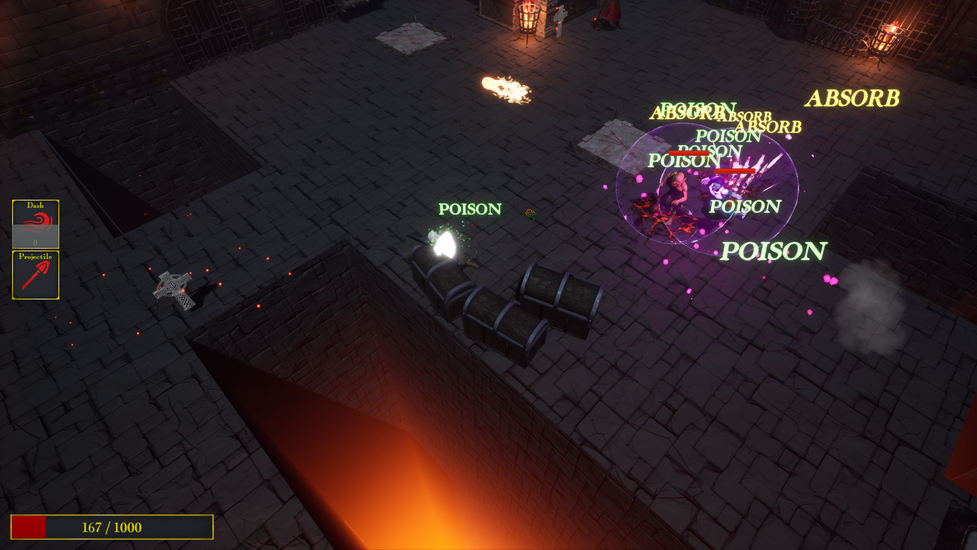
The Morrigan

Genre: Hack and Slash
Engine: Unreal Engine 4
Team size: 18
Duration: 10 weeks
Platform: PC
Project: The Morrigan
Role: Game designer
A captivating isometric hack and slash game, where players delve into a mythically-inspired world. Influenced by the gameplay dynamics of Hades, it challenges players with intense combat, strategic character mechanics, and immersive environmental obstacles. My role as a Lead Game/Level Designer involved conceptualizing mechanics, creating engaging levels and ensuring a balanced gameplay experience.
Responsibilities
-
Co-Leadership: As a co-leader, I guided the overall project and team efforts in game design and development.
-
Game Design Contributions: A key figure in the design team, shaping character mechanics, environmental challenges, and buffs. Involved in defining design pillars and gameplay loops.
-
Core Part of Enemy Design: Actively involved in creating all four enemy types and their mechanics, emphasizing strategic diversity in gameplay.
-
Game Balancing: Led the game balancing process, ensuring optimal character mechanics, enemy stats, environmental obstacles, pickups, and buffs.
-
Dynamic Enemy Spawn System: Designed a complex enemy spawning system, offering 3 layouts for diverse environments, significantly enhancing the game's replayability.
-
Level Design : Designed the first level, establishing foundational level design rules for scale, enemy crowd, difficulty levels and traps to guide the creation of subsequent levels. Designed and blocked-out two levels, covering eight rooms (levels 1 and 3), meshed out level 1.
Enemy Design
My role involved the ongoing design and balancing of enemies, guided by continual testing and feedback. Collaborating closely with other designers, I gathered their insights for each iteration of enemy development. Additionally, I implemented questionnaires to collect broader feedback on the enemy's design, ensuring a well-rounded and player-responsive AI development process
My thought process:
-
Enemies should maximize the player's movement.
-
The gameplay is designed to encourage aggressive play, such as rewarding players with health drops upon defeating enemies.
-
Due to time limitations, the enemies should have multiple variants for a diverse and enjoyable experience.
-
Faster enemies that can chase the player add dynamics to the gameplay.
-
Traps designed to make players consider their navigation strategy: they can either play aggressively and dodge risks or opt for a more cautious approach.
Game Balance
Balancing the game was a complex and challenging aspect of the project, involving numerous variables. Adjustments to entity stats had to be carefully managed to maintain equilibrium between the player character and enemies, ensuring the game was challenging yet enjoyable without being frustrating.
My approach began with fine-tuning character mechanics based on personal testing and feedback from other designers. This initial phase laid the groundwork for subsequent adjustments to enemy characters, obstacles, and buffs, striving for an optimal balance throughout the game.

Level Design
In my role, I was in charge of the core level design principles and philosophy, which included creating and iteratively improving a demo level to serve as a base template.
My approach began with simple room layouts, focusing on testing player movement:
-
Obstacle Placement: I evaluated the distance between obstacles and its impact on player movement fluidity.
-
Enemy Placement: Considered the balance between the time it takes for a player to defeat an enemy and the time for enemies to reach the player.
-
Escape Routes: Designed areas where players could dash through unwalkable terrain.
An initial design allowed players to fall out of rooms, but feedback indicated this was frustrating. I then enclosed the rooms and placed obstacles around edges, encouraging combat in the center. This change significantly improved gameplay, allowing players to focus on engaging with enemies and avoiding traps, without the risk of falling.
My thought process:
-
The player should be able to escape enemies so there shouldn't be corridor like rooms, maintaining intensity as ranged enemies can always attack.
-
Rooms should be designed so the player can quickly understand the pathway upon spawning.
-
Traps ought to block certain paths, forcing the player to weigh the risks.
-
There should be circular pathways for the player to navigate around.
Level 1
Level 3
Environment highlights






































